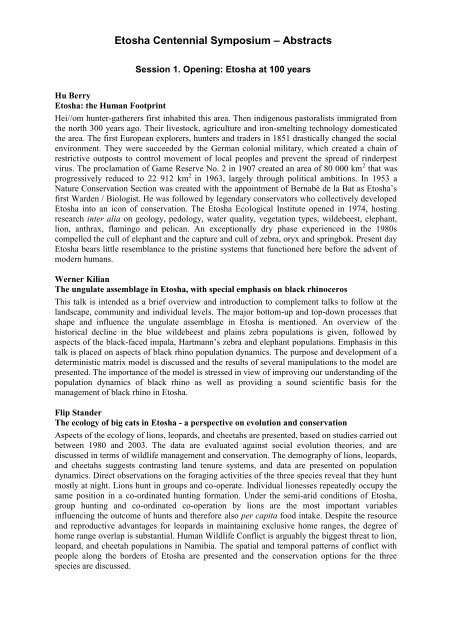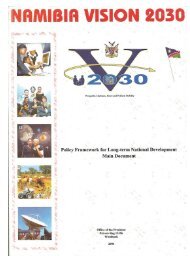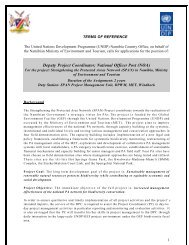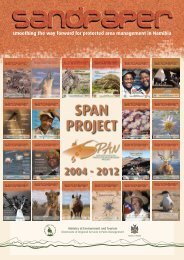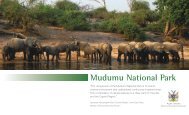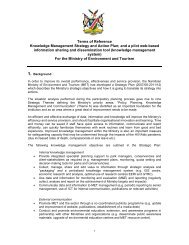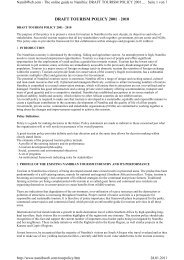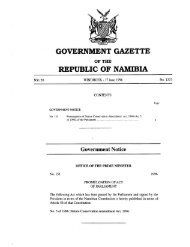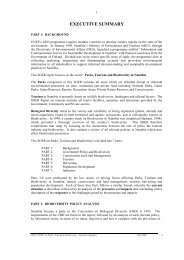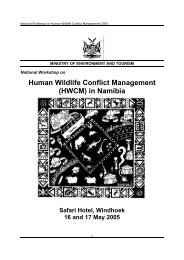Etosha: the Human Footprint - Ministry of Environment and Tourism
Etosha: the Human Footprint - Ministry of Environment and Tourism
Etosha: the Human Footprint - Ministry of Environment and Tourism
You also want an ePaper? Increase the reach of your titles
YUMPU automatically turns print PDFs into web optimized ePapers that Google loves.
<strong>Etosha</strong> Centennial Symposium – Abstracts<br />
Session 1. Opening: <strong>Etosha</strong> at 100 years<br />
Hu Berry<br />
<strong>Etosha</strong>: <strong>the</strong> <strong>Human</strong> <strong>Footprint</strong><br />
Hei//om hunter-ga<strong>the</strong>rers first inhabited this area. Then indigenous pastoralists immigrated from<br />
<strong>the</strong> north 300 years ago. Their livestock, agriculture <strong>and</strong> iron-smelting technology domesticated<br />
<strong>the</strong> area. The first European explorers, hunters <strong>and</strong> traders in 1851 drastically changed <strong>the</strong> social<br />
environment. They were succeeded by <strong>the</strong> German colonial military, which created a chain <strong>of</strong><br />
restrictive outposts to control movement <strong>of</strong> local peoples <strong>and</strong> prevent <strong>the</strong> spread <strong>of</strong> rinderpest<br />
virus. The proclamation <strong>of</strong> Game Reserve No. 2 in 1907 created an area <strong>of</strong> 80 000 km 2 that was<br />
progressively reduced to 22 912 km 2 in 1963, largely through political ambitions. In 1953 a<br />
Nature Conservation Section was created with <strong>the</strong> appointment <strong>of</strong> Bernabè de la Bat as <strong>Etosha</strong>‟s<br />
first Warden / Biologist. He was followed by legendary conservators who collectively developed<br />
<strong>Etosha</strong> into an icon <strong>of</strong> conservation. The <strong>Etosha</strong> Ecological Institute opened in 1974, hosting<br />
research inter alia on geology, pedology, water quality, vegetation types, wildebeest, elephant,<br />
lion, anthrax, flamingo <strong>and</strong> pelican. An exceptionally dry phase experienced in <strong>the</strong> 1980s<br />
compelled <strong>the</strong> cull <strong>of</strong> elephant <strong>and</strong> <strong>the</strong> capture <strong>and</strong> cull <strong>of</strong> zebra, oryx <strong>and</strong> springbok. Present day<br />
<strong>Etosha</strong> bears little resemblance to <strong>the</strong> pristine systems that functioned here before <strong>the</strong> advent <strong>of</strong><br />
modern humans.<br />
Werner Kilian<br />
The ungulate assemblage in <strong>Etosha</strong>, with special emphasis on black rhinoceros<br />
This talk is intended as a brief overview <strong>and</strong> introduction to complement talks to follow at <strong>the</strong><br />
l<strong>and</strong>scape, community <strong>and</strong> individual levels. The major bottom-up <strong>and</strong> top-down processes that<br />
shape <strong>and</strong> influence <strong>the</strong> ungulate assemblage in <strong>Etosha</strong> is mentioned. An overview <strong>of</strong> <strong>the</strong><br />
historical decline in <strong>the</strong> blue wildebeest <strong>and</strong> plains zebra populations is given, followed by<br />
aspects <strong>of</strong> <strong>the</strong> black-faced impala, Hartmann‟s zebra <strong>and</strong> elephant populations. Emphasis in this<br />
talk is placed on aspects <strong>of</strong> black rhino population dynamics. The purpose <strong>and</strong> development <strong>of</strong> a<br />
deterministic matrix model is discussed <strong>and</strong> <strong>the</strong> results <strong>of</strong> several manipulations to <strong>the</strong> model are<br />
presented. The importance <strong>of</strong> <strong>the</strong> model is stressed in view <strong>of</strong> improving our underst<strong>and</strong>ing <strong>of</strong> <strong>the</strong><br />
population dynamics <strong>of</strong> black rhino as well as providing a sound scientific basis for <strong>the</strong><br />
management <strong>of</strong> black rhino in <strong>Etosha</strong>.<br />
Flip St<strong>and</strong>er<br />
The ecology <strong>of</strong> big cats in <strong>Etosha</strong> - a perspective on evolution <strong>and</strong> conservation<br />
Aspects <strong>of</strong> <strong>the</strong> ecology <strong>of</strong> lions, leopards, <strong>and</strong> cheetahs are presented, based on studies carried out<br />
between 1980 <strong>and</strong> 2003. The data are evaluated against social evolution <strong>the</strong>ories, <strong>and</strong> are<br />
discussed in terms <strong>of</strong> wildlife management <strong>and</strong> conservation. The demography <strong>of</strong> lions, leopards,<br />
<strong>and</strong> cheetahs suggests contrasting l<strong>and</strong> tenure systems, <strong>and</strong> data are presented on population<br />
dynamics. Direct observations on <strong>the</strong> foraging activities <strong>of</strong> <strong>the</strong> three species reveal that <strong>the</strong>y hunt<br />
mostly at night. Lions hunt in groups <strong>and</strong> co-operate. Individual lionesses repeatedly occupy <strong>the</strong><br />
same position in a co-ordinated hunting formation. Under <strong>the</strong> semi-arid conditions <strong>of</strong> <strong>Etosha</strong>,<br />
group hunting <strong>and</strong> co-ordinated co-operation by lions are <strong>the</strong> most important variables<br />
influencing <strong>the</strong> outcome <strong>of</strong> hunts <strong>and</strong> <strong>the</strong>refore also per capita food intake. Despite <strong>the</strong> resource<br />
<strong>and</strong> reproductive advantages for leopards in maintaining exclusive home ranges, <strong>the</strong> degree <strong>of</strong><br />
home range overlap is substantial. <strong>Human</strong> Wildlife Conflict is arguably <strong>the</strong> biggest threat to lion,<br />
leopard, <strong>and</strong> cheetah populations in Namibia. The spatial <strong>and</strong> temporal patterns <strong>of</strong> conflict with<br />
people along <strong>the</strong> borders <strong>of</strong> <strong>Etosha</strong> are presented <strong>and</strong> <strong>the</strong> conservation options for <strong>the</strong> three<br />
species are discussed.
Session 2. <strong>Etosha</strong>: L<strong>and</strong>scape <strong>and</strong> Ecosystem<br />
Johan T. du Toit<br />
Identifying <strong>the</strong> most effective intervention points for wildl<strong>and</strong> conservation: working across<br />
spatio-temporal scales<br />
Practitioners <strong>of</strong> conservation biology <strong>and</strong> park management are faced with a common dilemma:<br />
how to effectively deploy limited financial <strong>and</strong> human resources <strong>and</strong> respond quickly to<br />
perceived conservation crises. If practitioners „get it wrong‟ <strong>the</strong>y waste time <strong>and</strong> money, <strong>and</strong><br />
damage <strong>the</strong> essential trust that has been nurtured between stakeholders <strong>and</strong> park managers. To be<br />
successful, interventions should be applied at <strong>the</strong> spatial scale at which <strong>the</strong> problem is generated,<br />
even if <strong>the</strong> immediate problem was perceived at a different scale. By way <strong>of</strong> analogy, consider<br />
how a microscope is used – <strong>the</strong> investigator racks up <strong>and</strong> down using lenses <strong>of</strong> different<br />
magnification before selecting a setting that provides <strong>the</strong> clearest view – but <strong>the</strong> final setting<br />
could not be arrived at without first racking up <strong>and</strong> down. In contrast, wildl<strong>and</strong> conservation<br />
interventions are <strong>of</strong>ten directed at “pet projects” that cannot possibly lead to long-term solutions<br />
because causes <strong>of</strong> <strong>the</strong> problem occur at different spatial/temporal scales or levels <strong>of</strong> institutional<br />
organization. Fur<strong>the</strong>rmore, <strong>the</strong> timing <strong>of</strong> an intervention (initiation <strong>and</strong> duration) should be<br />
considered on <strong>the</strong> basis <strong>of</strong> its likelihood <strong>of</strong> success – if a problem is beyond feasible help <strong>the</strong>n<br />
resources should be redirected to more promising projects. Finally, <strong>the</strong> opportunity costs <strong>of</strong><br />
imposing a conservation „solution‟ to a social-ecological system should be thoroughly evaluated<br />
prior to intervention. African savanna case studies will be used to illustrate <strong>the</strong>se issues. My<br />
aim is to stimulate discussion about <strong>the</strong> management <strong>of</strong> <strong>Etosha</strong> in <strong>the</strong> context <strong>of</strong> <strong>the</strong> broader<br />
social-ecological system within which it is embedded.<br />
Rudi van Aarde, Sam Ferreira, Jessi Junker & Yol<strong>and</strong>i de Beer<br />
Elephants in time <strong>and</strong> across space: <strong>the</strong> Namibian experience<br />
The management <strong>of</strong> sou<strong>the</strong>rn Africa‟s elephants is complex. This is also true for Namibia where<br />
high elephant numbers are blamed for degrading vegetation <strong>and</strong> where elephants come into<br />
conflict with <strong>the</strong> subsistence way <strong>of</strong> living. However, across sou<strong>the</strong>rn Africa high elephant<br />
numbers <strong>of</strong>ten result from management interferences that limit dispersal <strong>and</strong> seasonal<br />
movements. Elephant numbers <strong>of</strong> <strong>the</strong> <strong>Etosha</strong> National Park show no definable trend for <strong>the</strong> past<br />
20 years. Population growth for <strong>the</strong> relatively small population in <strong>the</strong> west <strong>of</strong> Namibia is not<br />
following a specific trend. Populations elsewhere in <strong>the</strong> Caprivi <strong>and</strong> Kavango districts are ei<strong>the</strong>r<br />
increasing or decreasing. These populations, however, are no more than administrative entities,<br />
as is also supported by our satellite tracking studies. Trends here <strong>the</strong>refore are primarily <strong>the</strong><br />
outcomes <strong>of</strong> inter-population <strong>and</strong> even between country movements, <strong>the</strong> dynamics <strong>of</strong> which are<br />
poorly understood. In Namibia, like elsewhere spatial utilisation by elephant is dictated by <strong>the</strong><br />
distribution <strong>of</strong> water more than anything else. The artificial distribution <strong>the</strong>re<strong>of</strong> <strong>the</strong>refore affects<br />
l<strong>and</strong>scape utilisation patterns <strong>and</strong> ultimately, <strong>the</strong> impact elephants may have for o<strong>the</strong>r species.<br />
Past management practices focussed on dealing with numbers <strong>and</strong> ignored <strong>the</strong> forces that gave<br />
rise to high numbers. Different to <strong>the</strong>se, management that aims at recovering dispersal <strong>and</strong><br />
seasonal movements can allow populations to be driven by natural events. Such an approach<br />
relies on restoring spatial utilisation <strong>of</strong> l<strong>and</strong>scapes associated with season <strong>and</strong> <strong>the</strong> distribution <strong>of</strong><br />
water. It lets habitat selection determine habitat occupation <strong>and</strong> nurtures sub-populations with<br />
distinct dynamics as discrete entities within a metapopulation.<br />
Peter Van Coeverden de Groot<br />
Conservation genetics <strong>of</strong> Namibian black rhino<br />
Major conservation efforts have increased Diceros bicornis bicornis from ~ 100 (1960s) to > 600<br />
alive in Namibia. With 9 microsatellites from 145 adult D. b. bicornis collected 1989-2000, we<br />
asked are: a) <strong>the</strong> founders <strong>of</strong> introduced D. b. bicornis in Waterberg N. P. representative <strong>of</strong><br />
<strong>Etosha</strong> N. P. genetic diversity, b) <strong>the</strong>re genetic groups within D. b. bicornis, c) <strong>the</strong>re spatially<br />
distinct genetic groups within <strong>Etosha</strong> N.P. rhino <strong>and</strong> d) <strong>the</strong>re differences in dispersal scale among<br />
2
male <strong>and</strong> female rhinos. Waterberg founders had similar levels <strong>of</strong> expected heterozygosity to<br />
<strong>Etosha</strong> rhinos: He = 0.526 ± 0.014 (±SE) vs. 0.522 ± 0.004, but s lower number <strong>of</strong> alleles:<br />
3.8±0.3 vs. 5.2 ± 0.2. Bayesian analyses (STRUCTURE) showed no genetic structure in <strong>the</strong> 145<br />
rhino under conditions <strong>of</strong> admixture/no admixture <strong>of</strong> source populations <strong>and</strong><br />
correlated/uncorrelated allele frequencies for sexes combined <strong>and</strong> apart. Spatial analyses<br />
(BARRIER) <strong>of</strong> inter-individual genetic distance among all <strong>Etosha</strong> residents (n=110), suggested<br />
no subdivision. However males in <strong>the</strong> northwest appear segregated from o<strong>the</strong>r <strong>Etosha</strong> males.<br />
Inter-individual spatial genetic autocorrelation suggest <strong>Etosha</strong> rhinos are not r<strong>and</strong>omly dispersed,<br />
with females showing greater autocorrelation at lower distance classes than males at 10, 25 <strong>and</strong><br />
40km scales. Although spatial-genetic signals are stronger when limited to 1998-2000 samples, it<br />
is likely to few generations have passed for putative social groups to be genetically differentiated.<br />
Christian Wissel, M. Franz, W. Kilian, J. Groeneveld, S. Kramer-Schadt<br />
Simulation <strong>of</strong> vegetation change caused by elephants around waterholes<br />
A process-based, spatially explicit simulation model is introduced which describes <strong>the</strong> interaction<br />
<strong>of</strong> variable rain fall, woody vegetation dynamics <strong>and</strong> elephant foraging behaviour around<br />
waterholes. An aggregated description <strong>of</strong> <strong>the</strong> vegetation <strong>and</strong> <strong>the</strong> elephants is used which reduces<br />
model complexity <strong>and</strong> number <strong>of</strong> parameters. In this way a good parametrization could be<br />
obtained which reproduces <strong>the</strong> empirical findings sufficiently well. Parameter values for which<br />
no empirical data exist could be determined by pattern-oriented modelling (inverse modelling). In<br />
this procedure field data on <strong>the</strong> spatial distribution <strong>of</strong> elephants at different times <strong>of</strong> day are used.<br />
A sigmoid vegetation gradient around waterholes is found by <strong>the</strong> model. It has been investigated<br />
how its characteristics are influenced by <strong>the</strong> number <strong>of</strong> elephants <strong>and</strong> amount <strong>and</strong> temporal<br />
pattern <strong>of</strong> rain.<br />
Anna Treydte<br />
Does a grazer need trees The attractiveness <strong>of</strong> below-crown grasses in African savannas<br />
The current decline in large tree cover raises questions about <strong>the</strong> importance <strong>of</strong> trees for <strong>the</strong><br />
surrounding flora <strong>and</strong> fauna in African savannas. Trees compete with but also facilitate growth <strong>of</strong><br />
<strong>the</strong> herbaceous layer underneath <strong>the</strong>ir canopies but studies on differences in sub-canopy grass<br />
quality for grazing wildlife have been scarce. We studied <strong>the</strong> nutrient content, structure, st<strong>and</strong>ing<br />
crop, <strong>and</strong> species composition <strong>of</strong> <strong>the</strong> grass layer beneath <strong>and</strong> outside <strong>of</strong> canopies for different<br />
eastern <strong>and</strong> sou<strong>the</strong>rn African savannas over season. Grass leaf nitrogen <strong>and</strong> phosphorus contents<br />
were up to 25% higher beneath than outside canopies in <strong>the</strong> site <strong>of</strong> lowest rainfall <strong>and</strong> soil<br />
fertility. Grass structure <strong>and</strong> species composition differed strongly beneath <strong>and</strong> outside <strong>of</strong> trees,<br />
with <strong>the</strong> tall <strong>and</strong> nutrient-rich Panicum maximum dominating sub-canopy. Sub-canopy grasses<br />
were grazed more than outside <strong>of</strong> canopies, <strong>and</strong> wild herbivore species, such as <strong>the</strong> zebra (Equus<br />
burchelli), grazed more <strong>of</strong>ten than expected underneath canopies compared to open grassl<strong>and</strong>.<br />
We propose that large trees are important grass quality improvers <strong>and</strong>, consequently, provide an<br />
essential food resource for grazing ungulates in savanna ecosystems. Hence, conservation efforts<br />
should aim at protecting trees, particularly in dry <strong>and</strong> dystrophic savannas, as <strong>the</strong>ir sub-canopy<br />
grasses seem to benefit grazing wildlife. Management strategies <strong>of</strong> both protected areas <strong>and</strong><br />
livestock pastures should fur<strong>the</strong>r maintain large trees to ensure sustainable grass resources for<br />
herbivores in African savannas.<br />
Chuck Rumsey<br />
Kunene Regional Ecological Assessment<br />
A regional ecological assessment for <strong>the</strong> Huab, Koigab, Uniab <strong>and</strong> Haunib river catchements is<br />
now underway in Namibia‟s northwest. The assessment is focused on <strong>the</strong> collection <strong>of</strong> detailed<br />
information on <strong>the</strong> region‟s wildlife, ecosystems, <strong>and</strong> l<strong>and</strong> uses, <strong>and</strong> will make use <strong>of</strong> <strong>the</strong> best<br />
available scientific data alongside <strong>of</strong> local <strong>and</strong> traditional knowledge. Information will be<br />
organized <strong>and</strong> mapped in order to build a robust knowledge-based framework that can continue<br />
to grow <strong>and</strong> be shared with local communities <strong>and</strong> decision-makers over time. We view this<br />
ecological assessment as a critical step for <strong>the</strong> establishment <strong>of</strong> coordinated conservation<br />
3
management planning <strong>and</strong> decision-support across multiple administrative boundaries <strong>and</strong><br />
jurisdictions, including <strong>the</strong> proposed linkage <strong>of</strong> Skeleton Coast <strong>and</strong> <strong>Etosha</strong> National Parks.<br />
Session 3. <strong>Etosha</strong>: Individuals <strong>and</strong> Communities<br />
Peter C.B. Turnbull<br />
A quarter century <strong>of</strong> progress on underst<strong>and</strong>ing anthrax in <strong>Etosha</strong> <strong>and</strong> its wider<br />
applications <strong>and</strong> benefits<br />
A population crash among blue wildebeest (Connochaetes taurinus) in <strong>Etosha</strong> between 1955 <strong>and</strong><br />
1975 was perceived to be <strong>the</strong> result <strong>of</strong> a combination <strong>of</strong> natural <strong>and</strong> human-induced factors. One<br />
<strong>of</strong> <strong>the</strong> principal factors thought to be involved was an upsurge <strong>of</strong> anthrax, in turn believed to be<br />
related in some way to <strong>the</strong> gravel pits which resulted from excavations <strong>of</strong> gravel for constructing<br />
<strong>the</strong> tourist roads in <strong>the</strong> Park. In 1982, anthrax was obviously still occurring with considerable<br />
frequency in <strong>Etosha</strong> <strong>and</strong>, at a chance meeting, Park veterinarian Ian H<strong>of</strong>meyr asked Peter<br />
Turnbull if he might be able to help address <strong>the</strong> questions: (1) how extensive is anthrax in<br />
<strong>Etosha</strong> (2) is it a “problem” (3) how is it getting around, <strong>and</strong> (4) how should it be dealt with<br />
The result <strong>of</strong> this chance meeting was a collaborative research endeavour to address <strong>the</strong>se<br />
questions between Peter Turnbull <strong>and</strong> colleagues in <strong>the</strong> UK <strong>and</strong> USA <strong>and</strong> Namibian <strong>Ministry</strong> <strong>of</strong><br />
<strong>Environment</strong> <strong>and</strong> <strong>Tourism</strong> veterinarians <strong>and</strong> research scientists lasting a quarter <strong>of</strong> a century. In<br />
general, while incidence levels <strong>and</strong> seasonalities showed that anthrax is ever-present in some<br />
„enzootic areas‟ <strong>of</strong> <strong>the</strong> Park, albeit with seasonal variation in numbers <strong>of</strong> cases, it was not ratelimiting<br />
for any <strong>of</strong> <strong>the</strong> affected species except <strong>the</strong> elephant (Loxodonta africana), in which it was<br />
only very slightly rate limiting. It was not, <strong>the</strong>refore, sensu strictu “a problem”. Ecological<br />
studies over <strong>the</strong> 25-year period included (1) examination <strong>of</strong> water holes to test <strong>the</strong> <strong>the</strong>ory <strong>of</strong> an<br />
association between <strong>the</strong>se <strong>and</strong> <strong>the</strong> disease incidence; (2) contamination levels <strong>and</strong> persistence <strong>of</strong><br />
contamination at anthrax carcass sites; (3) behavioural studies <strong>of</strong> Bacillus anthracis within blood<br />
from anthrax victims contaminating soils <strong>and</strong> water hole water; (4) spore levels in scavenger<br />
faeces to ascertain <strong>the</strong> likely importance <strong>of</strong> <strong>the</strong>se in transmission <strong>of</strong> <strong>the</strong> disease; (5) <strong>the</strong><br />
importance <strong>of</strong> wind in transmission <strong>of</strong> anthrax, <strong>and</strong> a number <strong>of</strong> subsidiary o<strong>the</strong>r studies, such as<br />
<strong>the</strong> survival <strong>of</strong> anthrax spores exposed to <strong>the</strong> <strong>Etosha</strong> sunlight. O<strong>the</strong>r studies, taking advantage <strong>of</strong><br />
techniques that became fashionable with time over <strong>the</strong> 25-year period, included serological<br />
studies to determine (1) whe<strong>the</strong>r, <strong>and</strong> to what extent, naturally acquired immunity develops in<br />
herbivores <strong>and</strong> carnivores in <strong>the</strong> Park, <strong>and</strong> (2) whe<strong>the</strong>r vaccination protocols being used or<br />
planned in <strong>Etosha</strong> for endangered species, rhino (Diceros bicornis) <strong>and</strong> cheetah (Acinonyx<br />
jubatus) were effective. Apart from vaccination, o<strong>the</strong>r approaches to control were addressed by<br />
discussion <strong>and</strong> logic, ra<strong>the</strong>r than by practical science. The results <strong>of</strong> all <strong>the</strong>se studies have been<br />
published <strong>and</strong> can be found in <strong>the</strong> references cited below. Beyond <strong>the</strong> boundaries <strong>of</strong> <strong>the</strong> <strong>Etosha</strong><br />
National Park, <strong>the</strong>y have made a substantial contribution to <strong>the</strong> underst<strong>and</strong>ing <strong>of</strong> anthrax, <strong>and</strong><br />
<strong>the</strong>nce to formulating management policies on an informed basis for o<strong>the</strong>r wildlife reserves, <strong>and</strong><br />
also for <strong>the</strong> disease in livestock <strong>and</strong> humans. Being so easy to identify <strong>and</strong> confirm, it has been<br />
easy to focus on anthrax as a major disease entity in <strong>Etosha</strong>. Regrettably, <strong>the</strong> morbidities <strong>and</strong><br />
mortalities <strong>of</strong> o<strong>the</strong>r diseases that probably influence <strong>the</strong> Park ecosystem in fundamental <strong>and</strong><br />
major ways have largely been neglected. While <strong>the</strong>re is yet a great deal more to learn <strong>and</strong><br />
underst<strong>and</strong> about anthrax, it is this author‟s earnest hope that it will not continue to be studied in<br />
isolation <strong>and</strong> that databases on o<strong>the</strong>r important diseases will be built up to <strong>the</strong> same extent as that<br />
on anthrax in <strong>the</strong> next quarter century.<br />
Hym Ebedes<br />
Memoirs <strong>of</strong> <strong>the</strong> first wildlife vet in <strong>the</strong> Great <strong>Etosha</strong><br />
In 1965 I was appointed as a Pr<strong>of</strong>essional Officer or Biologist at Okaukuejo. Several years later<br />
Head Office discovered that I was a Veterinarian. <strong>Etosha</strong> needed one <strong>and</strong> I admit that I was not a<br />
Biologist. Previous experience with wildlife was limited to some work on captive animals in a<br />
little zoo in Springs There were many Firsts. We flew 38 Black faced Impala in a SA Airforce<br />
4
Dakota from near <strong>the</strong> Cunene River to Namutoni. They were all tranquilized <strong>and</strong> only one animal<br />
died. Many ewes were pregnant <strong>and</strong> I could not see <strong>the</strong>se animals traveling that long distance by<br />
road in December. A few years later 72 fully immobilized <strong>and</strong> anaes<strong>the</strong>tized Roan Antelope were<br />
flown from Bushmanl<strong>and</strong> to Otjovas<strong>and</strong>u. Transporting <strong>the</strong>se rare animals by air saved <strong>the</strong>m<br />
from extinction in Namibia. Anglia Television made films called "The VIP‟S <strong>and</strong> "Air Support".<br />
O<strong>the</strong>r firsts included <strong>the</strong> immobilization <strong>of</strong> <strong>the</strong> first elephant, black rhino, lion, zebra, wildebeest,<br />
kudu, giraffe <strong>and</strong> springbok <strong>and</strong> marking some <strong>of</strong> <strong>the</strong>m for migration studies. Using a helicopter<br />
for <strong>the</strong> immobilization <strong>of</strong> rhinos <strong>and</strong> elephants was a big first in Africa. We hit <strong>the</strong> record <strong>of</strong><br />
marking 10 elephants in one day. The Bushmen helpers thought it was magic or witchcraft when<br />
<strong>the</strong> elephant stood up <strong>and</strong> w<strong>and</strong>ered <strong>of</strong>f after <strong>the</strong> antidote was injected. After a visit to Hluhluwe<br />
<strong>and</strong> Umfolozi Game Reserves we learnt a lot <strong>and</strong> were able to build bomas, rhino crates <strong>and</strong> start<br />
a fully equipped capture team under <strong>the</strong> supervision <strong>of</strong> my late vet. colleague Dr Ian H<strong>of</strong>meyr.<br />
Because I found so many Anthrax cases, <strong>the</strong> staff rumoured that I introduced <strong>the</strong> disease to<br />
<strong>Etosha</strong>. The many gravel pits used for graveling roads were suspected <strong>of</strong> being important sources<br />
<strong>of</strong> <strong>the</strong> infection because <strong>the</strong>y filled with rainwater <strong>and</strong> attracted many animals during <strong>the</strong> rainy<br />
season. Most <strong>of</strong> <strong>the</strong> gravel pits or "mini dams" <strong>and</strong> some <strong>of</strong> <strong>the</strong> windmills were disinfected <strong>and</strong><br />
closed <strong>and</strong> this seemed to control <strong>the</strong> disease to some extent. O<strong>the</strong>r firsts were aerial censuses to<br />
count <strong>Etosha</strong>‟s wildlife populations; getting an Ecological Institute with <strong>of</strong>fices, laboratories, a<br />
PM Room, <strong>and</strong> a Tea Room; getting university students like Roy Bengis, Willie Labuschagne<br />
<strong>and</strong> Russel Biggs in December <strong>and</strong> January to help out help with doing patrols etc when most <strong>of</strong><br />
<strong>the</strong> rangers were on holiday; getting <strong>the</strong> Red Line fence to be patrolled by staff <strong>of</strong> <strong>the</strong> Veterinary<br />
Department instead <strong>of</strong> rangers who had o<strong>the</strong>r more important conservation duties; getting<br />
additional research staff in 1968 for <strong>the</strong> Department (from 3 to 12) <strong>and</strong> my own ranger <strong>and</strong> a<br />
secretary; getting a committee that had to sort out local problems in <strong>Etosha</strong>; capturing <strong>and</strong> saving<br />
hundreds <strong>of</strong> fledgling flamingoes from starvation <strong>and</strong> thirst when <strong>the</strong> <strong>Etosha</strong> Pan dried up;<br />
proving to <strong>the</strong> Vet. Department that not all wild antelope were carriers <strong>of</strong> Foot <strong>and</strong> Mouth<br />
Disease in SWA; getting a fence around Sprokieswoud to stop elephants destroying <strong>the</strong> rare<br />
Moringas; starting <strong>the</strong> Wildlife Group <strong>of</strong> <strong>the</strong> SA Veterinary Association with <strong>the</strong> late Dr Eddie<br />
Young <strong>and</strong> Dr Piet Basson <strong>and</strong> organizing <strong>the</strong> first wildlife capture symposium at Onderstepoort.<br />
Wayne M. Getz<br />
A new anthrax study in <strong>Etosha</strong><br />
Anthrax provides a useful model system for studying fundamental questions in disease ecology.<br />
Our proposed research presents an integrative program to study anthrax in <strong>Etosha</strong> with its<br />
annually occurring seasonal outbreaks <strong>of</strong> <strong>the</strong> disease. Many factors can lead to seasonality <strong>of</strong><br />
disease outbreaks, including environmental effects on pathogen survival <strong>and</strong> transmission,<br />
development <strong>of</strong> parasites outside <strong>of</strong> hosts, host aggregation, seasonal shifts in host immunity,<br />
timing <strong>of</strong> breeding <strong>and</strong> reproduction for both hosts <strong>and</strong> pathogens <strong>and</strong> host foraging behavior.<br />
Using 40 years <strong>of</strong> spatially-explicit wildlife mortality <strong>and</strong> distribution data, targeted multi-year<br />
field <strong>and</strong> laboratory research, <strong>and</strong> statistical, dynamic <strong>and</strong> population models, this study provides<br />
an exceptional opportunity to identify factors that dictate <strong>the</strong> spatio-temporal pattern <strong>and</strong><br />
intensity <strong>of</strong> anthrax outbreaks. The proposed research uses cutting-edge molecular techniques in<br />
combination with detailed field monitoring <strong>and</strong> ecological experimentation to assess <strong>the</strong> relative<br />
contributions <strong>of</strong> 1) scavenging <strong>of</strong> infected host carcasses, 2) pathogen survival <strong>and</strong> reproduction<br />
in <strong>the</strong> environment, 3) pathogen genetics, 4)host genetics, 5) seasonal changes in host stress <strong>and</strong><br />
immunity, 6) coinfection by macroparasites <strong>and</strong> 7) seasonal changes in host spatial use <strong>and</strong><br />
behavior, to <strong>the</strong> timing <strong>and</strong> intensity <strong>of</strong> anthrax outbreaks. This research program will advance<br />
our underst<strong>and</strong>ing <strong>of</strong> a disease that, despite being known since ancient times, has remained<br />
something <strong>of</strong> a mystery in large part because its spores can persist for decades in <strong>the</strong><br />
environment.<br />
Wendy C. Turner, William C. Gasaway, J. Werner Kilian, George Wittemyer, Wilferd<br />
Versfeld, Kathleen T. Gasaway, Norman Owen-Smith<br />
Population dynamics <strong>of</strong> zebra, wildebeest <strong>and</strong> springbok in <strong>Etosha</strong> National Park<br />
Populations <strong>of</strong> plains ungulates in <strong>Etosha</strong> National Park, Namibia declined from <strong>the</strong> mid-1900s<br />
through <strong>the</strong> 1980s. These declines have been attributed to fencing <strong>of</strong> <strong>the</strong> reserve <strong>and</strong> adjacent<br />
5
farml<strong>and</strong> <strong>and</strong> <strong>the</strong> effects <strong>of</strong> anthrax, drought <strong>and</strong> predation. Concern over <strong>the</strong> viability <strong>of</strong> <strong>the</strong>se<br />
populations prompted <strong>the</strong> initiation <strong>of</strong> a twice-yearly monitoring program <strong>of</strong> group composition<br />
for Burchell‟s zebra, wildebeest <strong>and</strong> springbok. Using <strong>the</strong>se data from 1995-2006, we re-evaluate<br />
<strong>the</strong> dynamics <strong>of</strong> <strong>the</strong>se populations to assess how environmental variability affects juvenile<br />
recruitment <strong>and</strong> survival. <strong>Environment</strong>al variability is quantified using measures <strong>of</strong> rainfall <strong>and</strong><br />
<strong>the</strong> Normalized Difference Vegetation Index (NDVI), proxies for forage abundance <strong>and</strong><br />
vegetation growing season length.<br />
Martina Trinkel<br />
Spotted hyenas in <strong>Etosha</strong> National Park, Namibia<br />
Spotted hyena social <strong>and</strong> spatial organisation <strong>and</strong> <strong>the</strong> interaction between hyenas <strong>and</strong> lions are<br />
described. Clan size <strong>and</strong> structure differed between Central <strong>and</strong> Eastern <strong>Etosha</strong>. The study clan in<br />
Central <strong>Etosha</strong> comprised 8 adult hyenas, while <strong>the</strong> two study clans in Eastern <strong>Etosha</strong> comprised<br />
15 to 17 adults each. Reproductive success <strong>and</strong> survival rate were higher for hyenas in Eastern<br />
<strong>Etosha</strong>. The spatial organization <strong>of</strong> <strong>the</strong> clan in Central <strong>Etosha</strong> was investigated during <strong>the</strong> dry <strong>and</strong><br />
<strong>the</strong> wet season. The clan occupied a home range <strong>of</strong> 160 km2 in <strong>the</strong> dry season <strong>and</strong> 320 km2 in <strong>the</strong><br />
wet season. The dry season home range contained low densities (1 animal/km2) <strong>of</strong> resident<br />
herbivores, such as gemsbok, kudu, giraffe, steenbok <strong>and</strong> ostrich. The migratory species are <strong>the</strong><br />
more important prey (12 animals/km2) with springbok, zebra <strong>and</strong> wildebeest. During <strong>the</strong> wet<br />
season, <strong>the</strong> migratory herbivores migrated to northwest <strong>and</strong> left <strong>the</strong> area <strong>of</strong> <strong>the</strong> dry-season home<br />
range <strong>of</strong> <strong>the</strong> hyena clan. There existed a strong relationship between <strong>the</strong> abundance <strong>of</strong> hyenas<br />
within <strong>the</strong>ir dry <strong>and</strong> wet season home ranges regarding <strong>the</strong> abundance <strong>of</strong> <strong>the</strong>ir prey. In Central<br />
<strong>and</strong> Eastern <strong>Etosha</strong>, hyenas were unable to prevent kleptoparasitism by lions <strong>and</strong> failed to acquire<br />
kills from lions. The reasons were <strong>the</strong> small ratio <strong>of</strong> hyenas to female <strong>and</strong> sub-adult lions at kills<br />
<strong>and</strong> <strong>the</strong> presence <strong>of</strong> adult male lions. Because <strong>of</strong> <strong>the</strong> hyenas small clan sizes <strong>and</strong> large territories<br />
<strong>the</strong>y seemed to be unable to recruit sufficient clan members to take over lion kills or deter lions<br />
from <strong>the</strong>ir own kills. In <strong>Etosha</strong>, 71% <strong>of</strong> hyena mortality was due to lions.<br />
Caitlin O'Connell-Rodwell<br />
Multi-modal communication, relationships <strong>and</strong> hormones in <strong>the</strong> African elephant:<br />
Applications for conservation<br />
The structure <strong>of</strong> African elephant society is primarily matriarchal in nature, where dominant<br />
female elephants make decisions for <strong>the</strong> herd as a whole with regard to safety, movements,<br />
resource choices <strong>and</strong> affiliations. Aspects <strong>of</strong> elephant society that contribute to survival will be<br />
discussed in <strong>the</strong> context <strong>of</strong> long distance communication, local environmental <strong>and</strong> social<br />
pressures, as well as character <strong>of</strong> individual herd members. New findings about elephant bull<br />
society will be reviewed, highlighting <strong>the</strong> importance <strong>of</strong> bonding <strong>and</strong> mentoring <strong>and</strong> addressing<br />
potential applications to conservation.<br />
Eline Lorenzen<br />
Using genetic data to investigate potential hybridization between black-faced <strong>and</strong> common<br />
impala in <strong>Etosha</strong> National Park<br />
Nuclear genetic markers were used to determine if, <strong>and</strong> to what extent, hybridization occurs<br />
between <strong>the</strong> vulnerable endemic black-faced impala <strong>and</strong> introduced common impala in <strong>Etosha</strong>.<br />
No evidence <strong>of</strong> interbreeding between <strong>the</strong> two subspecies was found.<br />
Session 4. <strong>Etosha</strong> <strong>and</strong> Beyond<br />
Mutjinda Katjiua<br />
Pastoralists' perceptions <strong>and</strong> realities <strong>of</strong> vegetation change <strong>and</strong> browse consumption in <strong>the</strong><br />
nor<strong>the</strong>rn Kalahari, Namibia<br />
Pastoral production around artificial watering points in semi-arid environments affects <strong>the</strong><br />
density <strong>and</strong> composition <strong>of</strong> plant communities. In <strong>the</strong> Kalahari desert <strong>of</strong> southwestern Africa,<br />
bush encroachment is <strong>of</strong>ten regarded as <strong>the</strong> major form <strong>of</strong> l<strong>and</strong> degradation resulting from<br />
6
pastoral production around watering points. We investigated <strong>the</strong> OvaHerero pastoralists‟<br />
perceptions <strong>of</strong> <strong>the</strong> extent <strong>of</strong> vegetation change since <strong>the</strong> establishment <strong>of</strong> artificial watering points<br />
in <strong>the</strong> nor<strong>the</strong>rn Kalahari desert <strong>of</strong> Namibia, <strong>and</strong> related this to ecological data on vegetation<br />
change. We determined <strong>the</strong> utility <strong>of</strong> woody vegetation to pastoralists‟ livelihoods in terms <strong>of</strong><br />
provision <strong>of</strong> construction material, fuel wood <strong>and</strong> browse. We quantified local knowledge <strong>of</strong><br />
cattle browse consumption <strong>and</strong> correlated this with field data. We also assessed <strong>the</strong> purposes for<br />
which major livestock types were used. Our results showed that: 1) pastoral knowledge <strong>of</strong> bush<br />
encroachment <strong>and</strong> browse consumption was consistent with concurrently-collected field data, 2)<br />
<strong>the</strong> current level <strong>of</strong> bush encroachment was perceived to be beneficial for pastoral production,<br />
<strong>and</strong> 3) cattle played an important role in <strong>the</strong> production <strong>of</strong> milk <strong>and</strong> milk by-products for<br />
domestic use, <strong>and</strong> served as a source <strong>of</strong> cash income, while sheep <strong>and</strong> goats were primarily kept<br />
for meat consumption. This result contrasts with historical studies that mainly portray cattle as a<br />
symbol <strong>of</strong> social status among OvaHerero pastoralists.<br />
Keith Leggett<br />
The home ranges <strong>and</strong> movements <strong>of</strong> GPS collared elephants in Northwest Namibia<br />
This paper examines <strong>the</strong> home ranges <strong>and</strong> seasonal movements <strong>of</strong> ten GPS-collared elephants<br />
(two females <strong>and</strong> eight males) in <strong>the</strong> northwestern Kunene region <strong>of</strong> Namibia. The home ranges<br />
<strong>of</strong> <strong>the</strong> GPS collared elephants during <strong>the</strong> period 2002-2006 varied from between 769 to 14310<br />
km 2 . Minimum Convex Polygon (MCP) analysis was used to determine home ranges. In <strong>the</strong><br />
eastern section <strong>of</strong> <strong>the</strong> research area, <strong>the</strong> elephants generally had smaller home ranges <strong>and</strong> were at<br />
<strong>the</strong>ir least during <strong>the</strong> hot <strong>and</strong> cold dry seasons exp<strong>and</strong>ing during <strong>the</strong> wet season. In <strong>the</strong> western<br />
areas, <strong>the</strong> elephants moved between <strong>the</strong> Hoanib <strong>and</strong> Hoarusib Rivers in response to available<br />
vegetation that did not necessarily correspond to rainfall. While, in <strong>the</strong> north <strong>the</strong> elephants<br />
appear to have relatively small home ranges except for one male who moved between <strong>Etosha</strong><br />
National Park <strong>and</strong> <strong>the</strong> nor<strong>the</strong>rn Omusati region, this movement does not appear to be related to<br />
onset <strong>of</strong> <strong>the</strong> wet season. The length <strong>of</strong> movement <strong>of</strong> collared elephants varied from 55 to 625km,<br />
over periods <strong>of</strong> up to 5 months. The collared elephants showed defined home <strong>and</strong> seasonal<br />
ranges, annual variations in home range appear to be linked to rainfall.<br />
George Wittemyer<br />
Social dominance, seasonal movements, <strong>and</strong> spatial segregation in African elephants: A<br />
contribution to conservation behavior<br />
The structure <strong>of</strong> social relationships among individuals in a population is known to influence<br />
<strong>the</strong>ir fitness, access to resources, risk <strong>of</strong> predation, <strong>and</strong> even energy budgets. Among elephants,<br />
studies <strong>of</strong> population spatial structuring typically focus on <strong>the</strong> relationship between elephant<br />
range <strong>and</strong> distribution in relation to limiting factors such as water availability. In a study<br />
conducted on <strong>the</strong> semi-arid Samburu population <strong>of</strong> nor<strong>the</strong>rn Kenya, GPS radio telemetry<br />
provides data to evaluate <strong>the</strong> influence <strong>of</strong> both <strong>the</strong> distribution <strong>of</strong> resources <strong>and</strong> social<br />
relationships on population spatial structure <strong>and</strong> ranging tactics. Data collected from seven<br />
families <strong>of</strong> different rank demonstrate that dominant groups disproportionately use preferred<br />
habitats, limit <strong>the</strong>ir exposure to predation/conflict with humans by avoiding unprotected areas,<br />
<strong>and</strong> expend less energy than subordinate groups during <strong>the</strong> dry season. Hence our data provides<br />
strong evidence <strong>of</strong> rank derived spatial partitioning in this migratory species. These behaviors,<br />
however, were not found during <strong>the</strong> wet season indicating that spatial segregation <strong>of</strong> elephants is<br />
related to resource availability. Range-constriction increasingly confines elephant populations to<br />
ever shrinking safe areas. Our study <strong>of</strong>fers a rare <strong>and</strong> timely insight into <strong>the</strong> use <strong>of</strong> space in a<br />
population <strong>of</strong> elephants that still range relatively unconstrained. Our conclusions indicate social<br />
relationships can serve to mitigate <strong>the</strong> impacts <strong>of</strong> elephant density by driving dispersal <strong>of</strong> low<br />
ranking groups from favored areas during periods <strong>of</strong> constraints. Such impacts are only possible<br />
where dispersal regions <strong>and</strong> <strong>the</strong>ir corridors are maintained.<br />
Selma M. Lendelvo<br />
Underst<strong>and</strong>ing <strong>the</strong> importance <strong>of</strong> local level wildlife management to <strong>the</strong> livelihoods <strong>of</strong> <strong>the</strong><br />
communal Ehirovipuka Conservancy, west <strong>Etosha</strong><br />
7
This case study focuses on <strong>the</strong> Ehirovipuka communal conservancy, which is located in <strong>the</strong><br />
northwestern part <strong>of</strong> <strong>the</strong> Namibia <strong>and</strong> directly bordering <strong>Etosha</strong> National Park. Northwest is<br />
regarded as <strong>the</strong> richest region for wildlife species in <strong>the</strong> country. The aim <strong>of</strong> this study was to<br />
underst<strong>and</strong> <strong>the</strong> importance <strong>of</strong> conservancies in supporting livelihoods in a shifting society.<br />
Households were r<strong>and</strong>omly interviewed, using a structured questionnaire, from villages in <strong>the</strong><br />
conservancy including focused group discussions. The findings <strong>of</strong> <strong>the</strong> study showed that <strong>the</strong><br />
livelihood activities have been maintained over <strong>the</strong> years, although some changed in order <strong>of</strong><br />
importance. The current most important livelihood activities ranked by most households were<br />
mainly <strong>the</strong> cash-income. This suggests <strong>the</strong> shifting <strong>of</strong> <strong>the</strong> rural community to respond to <strong>the</strong><br />
national cash economy lifestyle. Three factors that maintained <strong>the</strong> livelihoods activities in <strong>the</strong><br />
Ehirovipuka conservancy emerged as access through strong social relations, diversification <strong>of</strong><br />
livelihood activities <strong>and</strong> <strong>the</strong> emergence <strong>of</strong> <strong>the</strong> community level support institutions such as <strong>the</strong><br />
conservancy. In conclusion, <strong>the</strong> conservancy is perceived as community level support that<br />
contributes to <strong>the</strong> improvement <strong>of</strong> natural resources which most livelihood activities depend on,<br />
hence, leading to <strong>the</strong> resilience <strong>of</strong> most livelihood activities.<br />
Peter Erb<br />
Future tourism developments in <strong>Etosha</strong><br />
The presentation gives <strong>and</strong> overview <strong>of</strong> <strong>the</strong> current tourism activities in <strong>Etosha</strong> <strong>and</strong> a summary <strong>of</strong><br />
developments planned to exp<strong>and</strong> <strong>and</strong> diversify tourism, both in <strong>the</strong> short-term as well as options<br />
for <strong>the</strong> longer term. Assuming a 5% growth, tourist visiting <strong>Etosha</strong> could increase from currently<br />
about 155 000 per year to 525 000 by 2030, i.e. over <strong>the</strong> next 25 years. To manage this potential<br />
dem<strong>and</strong> responsibly will ingenuity <strong>and</strong> some strategic far sightedness.<br />
Poster Session<br />
Steve Bellan<br />
Scavenger effects on Bacillus anthracis spore concentration at carcass sites<br />
Anthrax infects mammalian livestock <strong>and</strong> wildlife when susceptible hosts ingest Bacillus<br />
anthracis spores. Spores <strong>the</strong>n germinate into rapidly reproducing vegetative cells, killing hosts<br />
within days. Terminal hemorrhaging exposes vegetative cells to oxygen, facilitating sporulation.<br />
By opening carcasses, scavengers may expose more vegetative cells to oxygen, stimulating more<br />
sporulation. By moving carcasses, <strong>the</strong>y may also increase <strong>the</strong> area <strong>of</strong> spore contamination. Spore<br />
concentration <strong>and</strong> distribution influence <strong>the</strong> number <strong>of</strong> new anthrax cases seeded by spores at a<br />
carcass site. However, sporulation only continues for up to two days after host death. I will<br />
experimentally exclude scavengers from fresh anthrax-infected zebra (Equus burchelli) carcasses<br />
for three days <strong>and</strong> compare <strong>the</strong> subsequent spore concentrations <strong>and</strong> distributions at <strong>the</strong>se <strong>and</strong><br />
unmanipulated control carcasses. While anecdotal <strong>and</strong> observational evidence suggests that<br />
scavengers play a key role in <strong>the</strong> interannual maintenance <strong>and</strong> within-season epidemiology <strong>of</strong><br />
anthrax in herbivore assemblages, this will be <strong>the</strong> first experimental study to quantify <strong>the</strong>ir direct<br />
effect on spore loads at carcass sites.<br />
Rachel Br<strong>and</strong> <strong>and</strong> Morris Gosling<br />
Mating strategies <strong>of</strong> male giraffes (Giraffa camelopardalis) in <strong>Etosha</strong> National Park<br />
The giraffe (Giraffa camelopardalis) occupies a variety <strong>of</strong> habitats across sub-Saharan Africa. It<br />
is characterised by a loose social organisation, <strong>and</strong> a dominance-driven polygynous mating<br />
system. This project sought to test <strong>the</strong> hypo<strong>the</strong>sis that dark pelage colour in male giraffe is<br />
selected through sexual selection for a costly status signal. We also sought to test <strong>the</strong> hypo<strong>the</strong>sis<br />
that in a semi-arid environment, limited resources (food <strong>and</strong> water) would predictably<br />
concentrate females, increasing <strong>the</strong> potential for dominant males to monopolise matings. Field<br />
work was carried out in <strong>Etosha</strong> NP, Namibia. Using photographic records, we identified 431<br />
individual giraffe. The study area was surveyed regularly <strong>and</strong> data were collected on group<br />
composition, movements <strong>and</strong> behaviour. Darker males tended to be older <strong>and</strong> more dominant<br />
8
than lighter males, associated less with females, but had greater success in courting females. At<br />
waterholes, encounter rates were increased <strong>and</strong> consequently mating <strong>and</strong> agonistic interactions<br />
more frequent. Paler males had a greater chance <strong>of</strong> interacting with females at waterholes<br />
because <strong>of</strong> higher intruder pressure, but when present, darker males always monopolised<br />
courtship opportunities. Mature males demonstrated a diversity <strong>of</strong> ranging strategies that<br />
affected association with females. These individual differences are assumed to relate to status <strong>and</strong><br />
probably affect individual reproductive success. Evidence suggests male reproductive success is<br />
skewed towards mature dark males, but may also vary among dark males, with some potentially<br />
being excluded from mating.<br />
Carrie A. Cizauskas<br />
Seasonal aspects <strong>of</strong> host susceptibility to anthrax<br />
This work will involve <strong>the</strong> study <strong>of</strong> natural, seasonal anthrax outbreaks in plains ungulates in<br />
<strong>Etosha</strong> National Park, Namibia. We will test <strong>the</strong> hypo<strong>the</strong>sis that seasonal trends in anthrax<br />
outbreaks correspond with times <strong>of</strong> increased host stress <strong>and</strong> decreased host immunity. We will<br />
also investigate <strong>the</strong> immunomodulatory effects <strong>of</strong> gastrointestinal parasite coinfections in <strong>the</strong><br />
context <strong>of</strong> seasonal anthrax outbreaks. This research employs a novel approach to disease<br />
ecology both by examining internal host factors relating to disease in a natural system, <strong>and</strong> by<br />
studying <strong>the</strong> immunological mechanisms <strong>of</strong> disease in wildlife. Examining <strong>the</strong> immunological<br />
status <strong>and</strong> response <strong>of</strong> a host to a pathogen is important for underst<strong>and</strong>ing why natural hosts get<br />
<strong>the</strong> diseases that <strong>the</strong>y do when <strong>the</strong>y do. This, in turn, is critical for predicting <strong>and</strong> controlling<br />
outbreaks when necessary.<br />
Betsy Fox <strong>and</strong> Hu Berry<br />
Synchrony <strong>of</strong> drinking in Double-b<strong>and</strong>ed S<strong>and</strong>grouse, Pterocles bicinctus, at <strong>Etosha</strong><br />
National Park, Namibia<br />
Double-b<strong>and</strong>ed S<strong>and</strong>grouse, Pterocles bicinctus, at <strong>Etosha</strong> National Park in Namibia exhibit a<br />
predictable <strong>and</strong> remarkably synchronized activity pattern when flying to drink at water-holes.<br />
The primary environmental cue that activates this pattern appears to be decreasing light<br />
intensity. The species is highly synchronized in this regard, with an average interval <strong>of</strong> 16<br />
minutes after time <strong>of</strong> sunset <strong>and</strong> <strong>the</strong> time when s<strong>and</strong>grouse arrive at water. Birds stay at water for<br />
28 minutes on average. P. bicinctus numbers decrease significantly at artificially supplied water<br />
when rain falls. Floodlights have no significant effect on times <strong>of</strong> arrival or times <strong>of</strong> departure <strong>of</strong><br />
<strong>the</strong>se birds at drinking places. The predominantly crepuscular nature <strong>of</strong> Double-b<strong>and</strong>ed<br />
S<strong>and</strong>grouse may have evolved as part <strong>of</strong> <strong>the</strong>ir survival strategy by placing <strong>the</strong>m less at risk to<br />
diurnal raptors, <strong>and</strong> may also save energy <strong>and</strong> reduce evaporative water loss.<br />
Holly H. Ganz<br />
Pathogen genetics <strong>and</strong> <strong>the</strong> ecology <strong>of</strong> anthrax in <strong>Etosha</strong> National Park<br />
Genetic factors are likely to influence Bacillus anthracis virulence, playing a critical role in <strong>the</strong><br />
patterns <strong>of</strong> anthrax emergence. Differences in <strong>the</strong> timing <strong>of</strong> anthrax infection between zebra<br />
<strong>and</strong> elephant, for example, may be due to <strong>the</strong> occurrence <strong>of</strong> multiple pathogen genotypes but it<br />
is unknown whe<strong>the</strong>r different host species harbor, or are susceptible to, different genetic<br />
subtypes <strong>of</strong> B. anthracis. Recently B. anthracis strains were differentiated using variablenumber<br />
t<strong>and</strong>em repeat (VNTR) loci into six major strain groups worldwide, divided into two<br />
supergroups A <strong>and</strong> B. Type A genotypes are distributed around <strong>the</strong> world, including sou<strong>the</strong>rn<br />
Africa, <strong>and</strong> account for most anthrax outbreaks. Type B genotypes are dominated by isolates<br />
from sou<strong>the</strong>rn Africa. One Type B genotype appears to play an important role in <strong>the</strong> ongoing<br />
Kruger National Park anthrax outbreaks. Using molecular techniques, we can determine<br />
whe<strong>the</strong>r an outbreak is caused by one or several genotypes <strong>of</strong> a pathogen. We can also<br />
determine whe<strong>the</strong>r <strong>the</strong>re is an association between pathogen genotype <strong>and</strong> species <strong>of</strong> infected<br />
host. All isolates collected from <strong>Etosha</strong> so far belong to supergroup A. Although <strong>the</strong> amount<br />
<strong>of</strong> genetic variation in B. anthracis in ENP is not fully characterized, Keim found seven<br />
genotypes <strong>of</strong> B. anthracis in Namibia, from 23 isolates, <strong>and</strong> Beyer found ten genotypes in 54<br />
Namibian isolates. Among 32 isolates collected solely from <strong>Etosha</strong>, Beyer differentiated five<br />
9
genotypes. One <strong>of</strong> <strong>the</strong>se isolates represents a new genotype <strong>of</strong> B. anthracis. Two genotypes<br />
infected a broad range <strong>of</strong> hosts. However, isolates from cattle <strong>and</strong> goats in Namibia clearly<br />
differ from genotypes found infecting o<strong>the</strong>r hosts, suggesting that B. anthracis has <strong>the</strong><br />
capacity to evolve some degree <strong>of</strong> host specificity.<br />
Martin A. Haupt, Craig J. Tambling* & Elissa Z. Cameron<br />
Telemetry applications<br />
We illustrate some <strong>of</strong> <strong>the</strong> current GPS technology, ranging from <strong>the</strong> now widely used GPS/GSM<br />
collars to advancements based on a proximity tag system. Additionally, <strong>the</strong> ways in which data<br />
can be transmitted from <strong>the</strong> collars to a computer or server are discussed. Finally, we present<br />
some recommendations on <strong>the</strong> sizes <strong>of</strong> animals that each different collar type can be deployed on<br />
as well as suggestions to what collars would be best suited to research in <strong>Etosha</strong>.<br />
Mark Jago<br />
Incidence <strong>of</strong> rabies in Namibia<br />
Rabies is a notifiable disease in Namibia. The first confirmed case dates back to 1906 in<br />
Swakopmund. Canine rabies entered Namibia during <strong>the</strong> late 1940s from sou<strong>the</strong>rn<br />
Angola/Zambia <strong>and</strong> was later found to be phylogenetically different from <strong>the</strong> endemic mongoose<br />
(viverrid) strains circulating in <strong>the</strong> region. The disease cycling in black-back jackal soon<br />
appeared. By <strong>the</strong> mid 1970s <strong>the</strong> diseases was sporadic but endemic, with <strong>the</strong> dog/human form <strong>the</strong><br />
most common in nor<strong>the</strong>rn parts <strong>of</strong> <strong>the</strong> country, jackal/cattle in <strong>the</strong> central farml<strong>and</strong>s, <strong>and</strong> sporadic<br />
canine or mongoose in <strong>the</strong> arid sou<strong>the</strong>rn sheep l<strong>and</strong>s. Kudu (Tragelaphus stresiceros) rabies first<br />
appeared in 1975 near Windhoek. The epizootic began north <strong>of</strong> Okah<strong>and</strong>ja in 1977 with <strong>the</strong><br />
number <strong>of</strong> cases rising steadily throughout 1978-79. Peaking in 1980, <strong>the</strong> disease in kudu had<br />
subsided by 1985 by which time an estimated 30-50 000 kudu (20% <strong>of</strong> <strong>the</strong> population) had died.<br />
In 2002/3 ano<strong>the</strong>r kudu outbreak in <strong>the</strong> Omaruru/Wilhelmstal area resulted in estimated losses <strong>of</strong><br />
2500 animals on more than 81 farms (1). The social behaviour <strong>of</strong> kudu may have contributed to<br />
<strong>the</strong> spread <strong>of</strong> rabies, <strong>and</strong> one <strong>the</strong>ory is that mouth lesions from <strong>the</strong> browsing <strong>of</strong> thorn bushes may<br />
have been <strong>the</strong> route <strong>of</strong> entry due to <strong>the</strong> presence <strong>of</strong> Classical Rabies Virus (RABV) in saliva<br />
deposited on browse by o<strong>the</strong>r infected kudu. The kudu epizootics in Namibia have provided an<br />
example <strong>of</strong> non-bite transmission with horizontal spread between kudu. The incidence <strong>of</strong> rabies<br />
in this species appears to be related to <strong>the</strong> population density <strong>of</strong> <strong>the</strong> kudu. The rapid expansion <strong>of</strong><br />
game-pro<strong>of</strong> fences in <strong>the</strong> central farml<strong>and</strong>s has had <strong>the</strong> effect <strong>of</strong> both fencing in <strong>and</strong> out animals,<br />
<strong>the</strong>re by creating pockets <strong>and</strong> corridors <strong>of</strong> artificially high numbers <strong>and</strong> possibly predisposing to<br />
rabies spread. A panel <strong>of</strong> 37 rabies virus isolates originating mainly from <strong>the</strong> nor<strong>the</strong>rn <strong>and</strong><br />
central regions <strong>of</strong> Namibia between 1980 <strong>and</strong> 2003 demonstrated a high degree <strong>of</strong> genetic<br />
similarity. Virus isolates from kudu shared 97.2%-100% similarity with jackal isolates <strong>and</strong> 97-<br />
100% similarity with those from domestic dogs (2). 104 cases <strong>of</strong> human rabies (3) reported<br />
between 2001 <strong>and</strong> <strong>the</strong> present, occurring mainly in Nor<strong>the</strong>rn Namibia, demonstrate that <strong>the</strong><br />
disease remains a serious zoonosis with <strong>the</strong> domestic dogs being <strong>the</strong> primary source. Dog<br />
vaccination programs, stray dog control, <strong>and</strong> awareness campaigns on post exposure treatment<br />
continue in an attempt to mitigate <strong>the</strong> effects <strong>of</strong> <strong>the</strong> disease. Reasons as to why rabies has been<br />
maintained within <strong>the</strong> kudu population are speculative at best. Studies into behavioural ecology<br />
<strong>of</strong> <strong>the</strong> greater kudu are required to help to evaluate <strong>and</strong> quantify possible pathways <strong>of</strong> rabies<br />
transmission. Greater knowledge <strong>of</strong> <strong>the</strong> social interaction between <strong>and</strong> within groups <strong>of</strong> kudu,<br />
feeding behaviour <strong>and</strong> food preferences <strong>of</strong> kudus <strong>and</strong> o<strong>the</strong>r herbivores, <strong>the</strong> seasonal appearance<br />
<strong>of</strong> rabies <strong>and</strong> <strong>the</strong> effects <strong>of</strong> fencing <strong>and</strong> kudu-densities within fenced <strong>and</strong> non-fenced areas may<br />
help to answer some questions.<br />
Pauline L Kamath<br />
The role <strong>of</strong> host genetics in susceptibility to anthrax among Burchell’s zebra (Equus<br />
burchelli) <strong>of</strong> Sou<strong>the</strong>rn Africa<br />
Anthrax, caused by <strong>the</strong> bacteria Bacillus anthracis, is a highly infectious <strong>and</strong> <strong>of</strong>ten fatal epizootic<br />
disease affecting mammals. Today, even under <strong>the</strong> increased surveillance <strong>of</strong> national control<br />
10
programs, B. anthracis has a global distribution that threatens human health, agricultural<br />
production, biodiversity, <strong>and</strong> public security. Host genetic characteristics are likely to influence<br />
B. anthracis virulence <strong>and</strong> host susceptibility across individuals, populations, <strong>and</strong> species,<br />
playing a critical role in <strong>the</strong> observed patterns <strong>of</strong> anthrax outbreaks. Here, I present a proposal to<br />
investigate <strong>the</strong> role <strong>of</strong> host genetics in anthrax susceptibility within Burchell‟s zebra (Equus<br />
burchelli), <strong>the</strong> primary host species in <strong>Etosha</strong> National Park. First, a c<strong>and</strong>idate gene approach will<br />
be used to isolate <strong>and</strong> describe <strong>the</strong> variability in potential anthrax susceptibility genes within <strong>the</strong><br />
<strong>Etosha</strong> zebra population. Next, a preliminary population-based association study will be<br />
conducted to identify gene variants that may be associated with <strong>the</strong> disease phenotype (i.e.<br />
anthrax mortality). Finally, an inter-population comparison will be conducted to address <strong>the</strong><br />
genetic basis for <strong>the</strong> differences observed across zebra populations under varying levels <strong>of</strong><br />
anthrax intensities. These results may have implications for ecological risk assessment <strong>and</strong> could<br />
be used for screening individuals/populations to identify risk levels in wild <strong>and</strong> domestic<br />
ungulates, as well as humans. Fur<strong>the</strong>rmore, <strong>the</strong>se data will be incorporated into more<br />
comprehensive models <strong>of</strong> anthrax dynamics that may be useful for predicting <strong>and</strong> controlling<br />
future outbreaks.<br />
Birgit Kötting<br />
The Role <strong>of</strong> <strong>the</strong> Custodianship Program in <strong>the</strong> adaptive management <strong>of</strong> black rhinoceros<br />
Diceros bicornis bicornis in <strong>Etosha</strong> National Park<br />
Initiated in 1993, <strong>the</strong> Black Rhinoceros Custodianship Program <strong>of</strong> <strong>the</strong> Namibian <strong>Ministry</strong> <strong>of</strong><br />
<strong>Environment</strong> <strong>and</strong> <strong>Tourism</strong> facilitated <strong>the</strong> introduction <strong>of</strong> <strong>the</strong> first eleven black rhinoceroses to<br />
two free-hold farms with a combined size <strong>of</strong> 21 300 hectares. Today, 14 years later, <strong>the</strong><br />
Custodianship Program has grown into a respectable 26 l<strong>and</strong> units <strong>of</strong> 1 083 000 hectares, thus<br />
making large progress towards re-establishing this valuable subspecies in its former range within<br />
Namibia. <strong>Etosha</strong> National Park still remains <strong>the</strong> single most important donor <strong>of</strong> black rhinoceros<br />
by providing 65% <strong>of</strong> all animals introduced to <strong>the</strong> Black Rhinoceros Custodianship Program up<br />
to <strong>the</strong> end <strong>of</strong> 2006. This commitment carries with it a series <strong>of</strong> opportunities <strong>and</strong> challenges,<br />
which will determine <strong>the</strong> way forward for black rhinoceros conservation in Namibia.<br />
Gabriel Shatumbu <strong>and</strong> Meed Mbidzo<br />
Monitoring <strong>the</strong> illegal killing <strong>of</strong> elephants in <strong>Etosha</strong> National Park, Namibia<br />
MIKE (Monitoring <strong>the</strong> Illegal Killing <strong>of</strong> Elephants) was established by CITES to measure <strong>and</strong><br />
identify trends in <strong>the</strong> illegal killing <strong>of</strong> elephants in all elephant range states, to determine changes<br />
in <strong>the</strong>se trends <strong>and</strong> to assess whe<strong>the</strong>r <strong>and</strong> to what extent <strong>the</strong>se trends are a result <strong>of</strong> changes in <strong>the</strong><br />
status <strong>of</strong> elephants within CITES. Overall, <strong>the</strong> purpose <strong>of</strong> MIKE is to provide information needed<br />
for elephant range states to make appropriate management <strong>and</strong> enforcement decisions. The MIKE<br />
project was implemented in <strong>Etosha</strong> National Park (ENP) beginning <strong>of</strong> 2000, <strong>and</strong> it has been<br />
running since <strong>the</strong>n. The MIKE programme is based on <strong>the</strong> principle <strong>of</strong> routine <strong>and</strong> systematic<br />
collection <strong>of</strong> data using st<strong>and</strong>ardized protocols <strong>and</strong> techniques. In ENP, data is collected during<br />
routine vehicle <strong>and</strong> foot patrols as well as during aerial surveys that take place every second year.<br />
Data collected include live observations <strong>of</strong> elephants, elephant carcasses <strong>and</strong> any sign <strong>of</strong> illegal<br />
activities. Elephant population estimates are made from aerial survey data. Information is<br />
analyzed <strong>and</strong> summarized in form <strong>of</strong> monthly <strong>and</strong> annual reports.<br />
Craig J. Tambling, Wayne M. Getz, Johan T. du Toit & Elissa Z. Cameron<br />
Application <strong>of</strong> technology to future lion diet studies<br />
GPS/GSM collars were used to determine <strong>the</strong> diet <strong>of</strong> lion in <strong>the</strong> Satara region <strong>of</strong> Kruger National<br />
Park <strong>and</strong> <strong>the</strong> application <strong>of</strong> this technique as an alternative to continuous observations was<br />
investigated. On average feeding sites (kills/scavenged carcasses) were located 32 days<br />
following lion activity. The technique employed performed well with 303 feeding sites being<br />
located. In only 4% <strong>of</strong> all sites was <strong>the</strong> species consumed not determined. Known feeding sites<br />
were classified into known sex (86%) <strong>and</strong> known age (50%, excluding juveniles). There was no<br />
difference in determining <strong>the</strong> age or sex <strong>of</strong> <strong>the</strong> consumed individual at <strong>the</strong> feeding site if <strong>the</strong> point<br />
was followed up after a shorter time period. Feeding sites could, however, be located with<br />
11
greater accuracy if proximity tags <strong>and</strong> a 24 hour ratio were employed. The results suggest that<br />
<strong>the</strong> use <strong>of</strong> GPS/GSM collars performs adequately in determining lion diets (even down to <strong>the</strong> age<br />
determination <strong>of</strong> prey); although alternative methods are needed to augment this method if<br />
behavioural data is to be collected. A pilot period is suggested to determine if <strong>the</strong>se results are<br />
replicated in o<strong>the</strong>r regions.<br />
Peter Turnbull, Maria Diekmann, Werner Kilian, Wilferd Versfeld, Valerius de Vos,<br />
Lorraine Arntzen, Kerri Wolter, Paul Bartels <strong>and</strong> Antoinette Kotze<br />
Naturally acquired antibodies to Bacillus anthracis protective antigen in vultures <strong>of</strong><br />
Sou<strong>the</strong>rn Africa<br />
Elevated antibody titres to <strong>the</strong> anthrax toxin protective antigen (PA) were found in 12 <strong>of</strong> 19 (63<br />
%) wild caught Namibian vultures as compared with 0 <strong>of</strong> 12 South African equivalents. The<br />
results parallel <strong>the</strong> incidence <strong>of</strong> anthrax in nor<strong>the</strong>rn Namibia <strong>and</strong> South Africa <strong>and</strong> <strong>the</strong> likely<br />
contact <strong>of</strong> <strong>the</strong> vultures tested with anthrax carcasses. Numbers in <strong>the</strong> Namibian group were too<br />
small to determine any significances in species-, sex- or age-related differences within <strong>the</strong> raw<br />
data showing elevated titres in 4 <strong>of</strong> 6 Cape Griffons (Gyps copro<strong>the</strong>res), 6 <strong>of</strong> 10 White-backed<br />
vultures (Gyps africanus) <strong>and</strong> 1 <strong>of</strong> 3 Lappet-faced vultures (Aegypius tracheliotus), or in 5 <strong>of</strong> 6<br />
males versus 3 <strong>of</strong> 7 females, <strong>and</strong> 10 <strong>of</strong> 15 adults versus 1 <strong>of</strong> 4 juveniles. It is not known whe<strong>the</strong>r<br />
elevated titre indicates infection per se in vultures or absorption <strong>of</strong> incompletely digested<br />
epitopes <strong>of</strong> <strong>the</strong> toxin or both. The results are discussed in relation to distances travelled by<br />
vultures as determined by new tracking techniques, how serology can reveal anthrax activity in<br />
an area <strong>and</strong> <strong>the</strong> issue <strong>of</strong> <strong>the</strong> role <strong>of</strong> vultures in transmission <strong>of</strong> anthrax.<br />
Peter J. Van Coeverden de Groot, Nicholas Georgiadis, Keith Leggett, Betsy Fox, Don J.<br />
Melnick, Stephen J. OBrien <strong>and</strong> Alfred L. Roca<br />
Genetic variation in Namibian elephants<br />
Desert-adapted elephants inhabit <strong>the</strong> northwest Namibian deserts near <strong>the</strong> Hoanib <strong>and</strong> o<strong>the</strong>r river<br />
catchments, such as <strong>the</strong> Hoarusib. While <strong>the</strong>se unprotected animals currently number 800-1000,<br />
numbers were as low as 257 in <strong>the</strong> early 1980s. The population rebounded to more than 600<br />
individuals by <strong>the</strong> mid 1990s with <strong>the</strong> increase likely including some influx from populations to<br />
<strong>the</strong> east especially <strong>Etosha</strong> National Park (current size ~ 2600). To examine <strong>the</strong> genetic<br />
distinctiveness <strong>of</strong> desert-adapted elephants from o<strong>the</strong>r African savanna elephants (Loxodonta<br />
africana), <strong>and</strong> to look for genetic differentiation within <strong>Etosha</strong> <strong>and</strong> across Namibia, we amplified<br />
<strong>and</strong> sequenced mitochondrial DNA from desert-adapted elephants <strong>and</strong> from o<strong>the</strong>r Namibian<br />
populations. We sequenced portions <strong>of</strong> <strong>the</strong> mitochondrial cytB <strong>and</strong> control region in DNA from<br />
dung samples, <strong>and</strong> a 2.6 kb region <strong>of</strong> mitochondrial ND5 <strong>and</strong> ND6 in DNA from tissue samples.<br />
Additionally, 11 short t<strong>and</strong>em repeat (STR) or microsatellite nuclear loci were amplified using<br />
DNA from <strong>the</strong> tissue samples. Our results indicated that desert elephants are related to o<strong>the</strong>r<br />
African savanna elephants, especially those from nearby populations in Namibia. A low level <strong>of</strong><br />
genetic diversity is present among Namibias elephants, suggesting limited gene flow between<br />
<strong>the</strong>m <strong>and</strong> outside populations.<br />
Wilferd Versfeld<br />
<strong>Etosha</strong>’s small Blue Crane population: a genetic <strong>and</strong> conservation puzzle<br />
The Blue Crane (Anthropoides paradiseus) is <strong>the</strong> most range-restricted species <strong>of</strong> all <strong>the</strong> cranes.<br />
There are currently 20 000 birds in Sou<strong>the</strong>rn Africa, but an isolated group <strong>of</strong> birds exist in<br />
Namibia. The question arises as to how <strong>the</strong>se Blue Cranes survive in <strong>the</strong>se predator rich <strong>and</strong> arid<br />
conditions. The project entails a census <strong>of</strong> actual birds to previous estimates, as well as a study<br />
to compare <strong>the</strong> genetic material, <strong>and</strong> <strong>the</strong> behavioural patterns, <strong>of</strong> <strong>the</strong>se Namibian birds to o<strong>the</strong>r<br />
Blue Crane populations. The results from <strong>the</strong> investigations will assist in compiling a species<br />
management plan for <strong>the</strong> Blue Cranes in Namibia. The objective <strong>of</strong> this species management plan<br />
is to harmonize <strong>the</strong> sharing <strong>of</strong> habitats, between people <strong>and</strong> cranes.<br />
12


